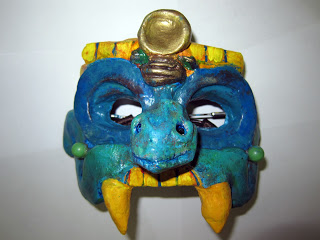 |
| A mask hand-crafted by Tim Krause for the actress playing Tlaloc |
Opening night of «Raíz», our Day of the Dead celebration, is just around the corner. To continue to whet your appetite for what’s to come, here is another selection from our study guide, here providing background information on some of the Aztec gods that are featured in this year’s story:
Quetzalcoatl ~ the feathered serpent, related to gods of the wind, of Venus, of the dawn, of merchants and of arts, crafts and knowledge. He was also the patron god of the Aztec priesthood, of learning and knowledge. Legend has it he introduced corn to humans, and taught them to cook, bake bread and make a beverage from the kernels. From an ideological standpoint, Quetzalcoatl the god was seen as the Lord of the Morning Star, the planet Venus. In Aztec tradition it was customary to offer two drops of blood from the ear when one saw the Morning Star. Quetzalcoatl also represented healing, magical herbs, beauty and poetry. He held the title of Lord of the Winds, and breathed life into all things of beauty. He is attributed with bringing inspiration to artists. Quetzalcoatl was known as the Lord of Life, and granted penitence and occasional exemption from blood sacrifice. He was seen as possessing great wisdom and love.
Tezcatlipoca ~ the smoking mirror, alluding to his connection to obsidian, the material from which mirrors were made in Mesoamerica and which was used for shamanic rituals. One of the four sons of Ometeotl, he is associated with a wide range of concepts, including the night sky, the night winds, hurricanes, the north, the earth, obsidian, enmity, discord, rulership, divination, temptation, jaguars, sorcery, beauty, war and strife. When depicted he was usually drawn with a black and a yellow stripe painted across his face. He is often shown with his right foot replaced with an obsidian mirror or a snake, an allusion to the creation myth in which he loses his foot battling with the Earth Monster. He is known as a trickster, believed to sit on every person’s shoulder, whispering and suggesting violent acts and trickery. Tezcatlipoca was a supernatural magician with the ability to shift shapes as he pleased, which he frequently used to facilitate his trickery in animal form. He was associated with the jaguar, and is often depicted this way in art.
Mictlantecuhtli ~ God of the dead and king of Mictlan, the worship of Mictlantecuhtli sometimes involved ritual cannibalism, with human flesh being consumed in and around the temple. Mictlantecuhtli was depicted as a blood-spattered skeleton or a person wearing a toothy skull. Although his head was typically a skull, his eye sockets did contain eyeballs. In the Aztec world, skeletal imagery was a symbol of fertility, health and abundance, alluding to the close symbolic links between death and life. Mictlanteculhtli was associated with spiders, owls, bats, the eleventh hour, and the northern compass direction. He was one of only a few gods said to govern over all three types of souls identified by the Aztecs. The Aztecs distinguished between the souls of people who died normal deaths (of old age, disease, etc.), heroic deaths (e.g. in battle, sacrifice or during childbirth), or non-heroic deaths.
Tlaloc ~ also known as “He Who Makes Things Sprout,” Tlaloc is commonly depicted as a blue being with jaguar fangs and an aura of clouds and a heron feather. He carried a rattle to produce thunder. God of water, rain, and fertility, Tlaloc was simultaneously worshipped out of the necessity to have crops grow during the rainy season and feared for his ability to bring storms that included lightning and hail. In cosmology, Tlaloc represented the ability to maintain a separation of earth and sky and the cyclic nature of the Aztec year as it coincided with the agricultural process. Many of the rituals surrounding Tlaloc involve the sacrifice of children, who would be beautifully adorned in the manner of the god in order to show devotion. The rituals would occur on shrine tops devoted to the god where there would also be pitchers of water attempting to bring about the rain. Because rain was so crucial to the operations of the normal peasant farmer in Aztec culture, Tlaloc was favored by the large majority of the population who had to survive on subsistence farming.

